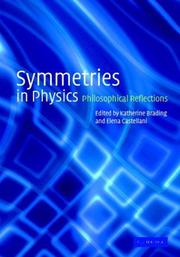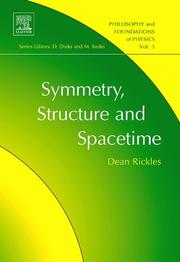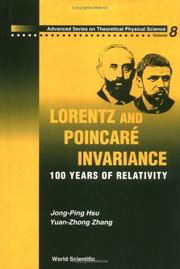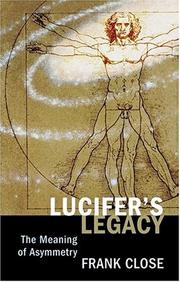| Listing 1 - 10 of 105 | << page >> |
Sort by
|

ISBN: 1107136504 1280430885 9786610430888 0511206062 0511169922 0511061870 0511297076 0511535368 0511070330 9780511061875 9780511070334 9780511535369 9781280430886 0521821371 9780521821377 0511055544 9780511055546 9780521528894 0521528895 Year: 2003 Publisher: Cambridge ; New York : Cambridge University Press,
Abstract | Keywords | Export | Availability | Bookmark
 Loading...
Loading...Choose an application
- Reference Manager
- EndNote
- RefWorks (Direct export to RefWorks)
Symmetry considerations dominate modern fundamental physics, both in quantum theory and in relativity. This book presents a collection of philosophy-on-physics papers, highlighting the main issues and controversies, and providing an entry into the subject for both physicists and philosophers. It covers topical issues such as the significance of gauge symmetry, particle identity in quantum theory, how to make sense of parity violation, the role of symmetry-breaking, the empirical status of symmetry principles, and so forth, along with more traditional problems in the philosophy of science. These include the status of the laws of nature, the relationships between mathematics, physical theory, and the world, and the extent to which mathematics dictates physics. A valuable reference for students and researchers, it will also be of interest to those studying the foundations of physics, philosophy of physics and philosophy of science.
Philosophy. --- Symmetry (Physics). --- Symmetry (Physics) --- Physics --- Invariance principles (Physics) --- Symmetry (Chemistry) --- Conservation laws (Physics)
Book
ISBN: 1282442708 9786612442704 9812835326 9789812835321 9789812835314 9812835318 9781282442702 Year: 2009 Publisher: Singapore ; Hackensack, N.J. : World Scientific,
Abstract | Keywords | Export | Availability | Bookmark
 Loading...
Loading...Choose an application
- Reference Manager
- EndNote
- RefWorks (Direct export to RefWorks)
From flowers to bridges, buildings, coke machines, and snowflakes; from molecules to walnuts, fences, pine cones, and sunflowers; from music to children's drawings; from hubcaps to bank logos, propellers, wallpaper decorations, and pavements, we recognize symmetry if we walk around with open eyes and an open mind. This book addresses symmetry.
Symmetry --- Symmetry (Physics) --- Invariance principles (Physics) --- Symmetry (Chemistry) --- Conservation laws (Physics) --- Physics --- Aesthetics --- Proportion
Book
ISBN: 9814350478 9789814350471 9789814350464 981435046X Year: 2012 Publisher: Singapore : World Scientific,
Abstract | Keywords | Export | Availability | Bookmark
 Loading...
Loading...Choose an application
- Reference Manager
- EndNote
- RefWorks (Direct export to RefWorks)
In theoretical physics, theoretical chemistry and engineering, one often wishes to solve partial differential equations subject to a set of boundary conditions. This gives rise to eigenvalue problems of which some solutions may be very difficult to find. For example, the problem of finding eigenfunctions and eigenvalues for the Hamiltonian of a many-particle system is usually so difficult that it requires approximate methods, the most common of which is expansion of the eigenfunctions in terms of basis functions that obey the boundary conditions of the problem. The computational effort needed
Symmetry (Physics) --- Invariance principles (Physics) --- Symmetry (Chemistry) --- Conservation laws (Physics) --- Physics
Book
ISBN: 3036558489 3036558470 Year: 2023 Publisher: Basel : MDPI,
Abstract | Keywords | Export | Availability | Bookmark
 Loading...
Loading...Choose an application
- Reference Manager
- EndNote
- RefWorks (Direct export to RefWorks)
This reprint is focuses on distributions and moments and publish papers on the theory and applications of probability and statistics. Papers include original results of symmetric random walks and their characterization, stochastic processes, stochastic integrals, martingales, probability inequalities, statistics parameter estimation, stochastic differential equations, fractional Brownian motions, continuous time random walk models, anomalous diffusion models, Black-Scholes models, Monte Carlo methods, etc. This Special Issue is focused on concepts and techniques and is oriented toward a broad spectrum of applied mathematics and sciences. Focused review articles reviewed the state of the art and identify upcoming challenges and promising solutions for the scientific community.
Symmetry (Physics) --- Invariance principles (Physics) --- Symmetry (Chemistry) --- Conservation laws (Physics) --- Physics

ISBN: 1281047457 9786611047450 0080552064 0444531165 9780080552064 9780444531162 Year: 2008 Volume: 3 Publisher: Amsterdam : Elsevier Science Pub,
Abstract | Keywords | Export | Availability | Bookmark
 Loading...
Loading...Choose an application
- Reference Manager
- EndNote
- RefWorks (Direct export to RefWorks)
In this book Rickles considers several interpretative difficulties raised by gauge-type symmetries (those that correspond to no change in physical state). The ubiquity of such symmetries in modern physics renders them an urgent topic in philosophy of physics. Rickles focuses on spacetime physics, and in particular classical and quantum general relativity. Here the problems posed are at their most pathological, involving the apparent disappearance of spacetime! Rickles argues that both traditional ontological positions should be replaced by a structuralist account according to which relational
Symmetry (Physics) --- Conservation laws (Physics) --- Invariance principles (Physics) --- Symmetry (Chemistry) --- Physical laws --- Physics --- Space and time --- Relativity (Physics) --- Quantum theory

ISBN: 1281956554 9786611956554 9812810986 9789812810984 9789810247218 9810247214 9810247214 9781281956552 Year: 2001 Publisher: River Edge, N.J. : World Scientific,
Abstract | Keywords | Export | Availability | Bookmark
 Loading...
Loading...Choose an application
- Reference Manager
- EndNote
- RefWorks (Direct export to RefWorks)
This collection of papers provides a broad view of the development of Lorentz and Poincaré invariance and space time symmetry throughout the past 100 years. The issues explored in these papers include: (1) formulations of relativity theories in which the speed of light is not a universal constant but which are consistent with the four-dimensional symmetry of the Lorentz and Poincaré groups and with experimental results, (2) analyses and discussions by Reichenbach concerning the concepts of simultaneity and physical time from a philosophical point of view, and (3) results achieved by the union
Symmetry (Physics) --- Relativity (Physics) --- Gravitation --- Nonrelativistic quantum mechanics --- Space and time --- Invariance principles (Physics) --- Symmetry (Chemistry) --- Conservation laws (Physics) --- Physics

ISBN: 9812793852 9789812793850 9810242069 9789810242060 Year: 2000 Publisher: Singapore ; River Edge, N.J. : World Scientific,
Abstract | Keywords | Export | Availability | Bookmark
 Loading...
Loading...Choose an application
- Reference Manager
- EndNote
- RefWorks (Direct export to RefWorks)
This invaluable volume is dedicated to the memory of Yuri Golfand, one of the discoverers of supersymmetry. Together with his student, he constructed in 1970 the superextension of the Poincaré algebra and obtained the first four-dimensional supersymmetric field theory, a version of supersymmetric QED. Golfand died in 1994 in Israel.Did the pioneers of supersymmetry - Neveu, Schwarz, Ramond, Golfand, Volkov, Wess, Zumino and others - foresee in the early 1970's that they would be opening to us the gates of the superworld? The superworld will become one of the most important components of our un
Supersymmetry. --- Symmetry (Physics) --- Invariance principles (Physics) --- Symmetry (Chemistry) --- Conservation laws (Physics) --- Physics --- Unified theories --- Particles (Nuclear physics)
Book
ISBN: 0191648809 0198807201 0191648795 0199669953 9780191648793 9780191648809 9781299684829 1299684823 9780199669950 Year: 2013 Publisher: Oxford, England : Oxford University Press,
Abstract | Keywords | Export | Availability | Bookmark
 Loading...
Loading...Choose an application
- Reference Manager
- EndNote
- RefWorks (Direct export to RefWorks)
In crystal chemistry and crystal physics, the relations between the symmetry groups (space groups) of crystalline solids are of special importance. Part 1 of this book presents the necessary mathematical foundations and tools: the fundamentals of crystallography with special emphasis on symmetry, the theory of the crystallographic groups, and the formalisms of the needed crystallographic computations. Part 2 gives an insight into applications to problems in crystal chemistry. Withthe aid of numerous examples, it is shown how crystallographic group theory can be used to make evident relationshi
Crystals --- Symmetry (Physics) --- Invariance principles (Physics) --- Symmetry (Chemistry) --- Conservation laws (Physics) --- Physics --- Crystallography --- Powders --- Solids --- Structure. --- Chemical and physical crystallography

ISBN: 9780511535369 9780521821377 9780521528894 0521528895 0521821371 Year: 2003 Publisher: Cambridge Cambridge University Press
Abstract | Keywords | Export | Availability | Bookmark
 Loading...
Loading...Choose an application
- Reference Manager
- EndNote
- RefWorks (Direct export to RefWorks)
Symmetry (Physics) --- Physics - Philosophy. --- Physics --- Symétrie (Physique) --- Physique --- Philosophy --- Philosophie --- Invariance principles (Physics) --- Symmetry (Chemistry) --- Conservation laws (Physics)

ISBN: 0198503806 Year: 2000 Publisher: Oxford ; New York : Oxford University Press,
Abstract | Keywords | Export | Availability | Bookmark
 Loading...
Loading...Choose an application
- Reference Manager
- EndNote
- RefWorks (Direct export to RefWorks)
Symmetry (Physics) --- Symétrie (Physique) --- 57.018.725 --- #GBIB:Overlegcentrum Christelijke Ethiek --- Asymmetry --- 57.018.725 Asymmetry --- Symétrie (Physique) --- Invariance principles (Physics) --- Symmetry (Chemistry) --- Conservation laws (Physics) --- Physics
| Listing 1 - 10 of 105 | << page >> |
Sort by
|

 Search
Search Feedback
Feedback About UniCat
About UniCat  Help
Help News
News